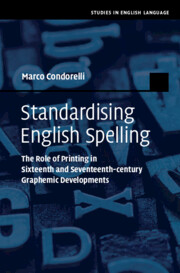 Standardising English Spelling
Standardising English Spelling from Part III - Case Studies
Published online by Cambridge University Press: 31 March 2022
The conclusion summarises the main points developed in the book, and provides more explicit answers to the questions posed at the beginning. From a large-scale perspective, the role of the printing press on the development of Early Modern English spelling was not only undoubtedly important; it was, I conclude, the primary agent responsible for shaping and disseminating a modern graphemic standard over the sixteenth and the seventeenth centuries. In theoretical terms, the patterns of development detected in my case studies suggest something peculiar about spelling standardisation in Early Modern English. Underneath the umbrella of standardisation, there are multiple processes of large-scale regularisation, which in turn are the motor of spelling standardisation itself. The history of Early Modern English spelling is not just part of a history of standard orthography, but also, perhaps even especially, a history of individual spellings. The chapter ends with suggestions for future research and some considerations about the relationship between the findings made in my piece of research and those from previous contributions.
To save this book to your Kindle, first ensure [email protected] is added to your Approved Personal Document E-mail List under your Personal Document Settings on the Manage Your Content and Devices page of your Amazon account. Then enter the ‘name’ part of your Kindle email address below. Find out more about saving to your Kindle.
Note you can select to save to either the @free.kindle.com or @kindle.com variations. ‘@free.kindle.com’ emails are free but can only be saved to your device when it is connected to wi-fi. ‘@kindle.com’ emails can be delivered even when you are not connected to wi-fi, but note that service fees apply.
Find out more about the Kindle Personal Document Service.
To save content items to your account, please confirm that you agree to abide by our usage policies. If this is the first time you use this feature, you will be asked to authorise Cambridge Core to connect with your account. Find out more about saving content to Dropbox.
To save content items to your account, please confirm that you agree to abide by our usage policies. If this is the first time you use this feature, you will be asked to authorise Cambridge Core to connect with your account. Find out more about saving content to Google Drive.